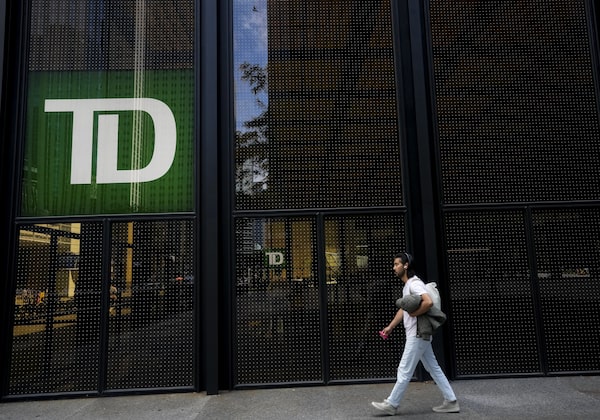
A man walks past the TD Bank in the Bay Street Financial District in Toronto on Aug. 5, 2022.Nathan Denette/The Canadian Press
Toronto-Dominion Bank TD-T reported adjusted fourth-quarter profits that beat expectations and raised its dividend as higher margins earned on loans helped drive strong retail banking returns in Canada and the U.S.
TD is one of three major banks to report earnings that were better than anticipated in the fiscal fourth quarter, which ended Oct. 31.
Its results were helped by a favourable tax rate, and included two large items that boosted results: a $2.3-billion gain on an interest-rate hedging strategy tied to its US$13.4-billion acquisition of First Horizon Corp., and a $997-million gain on the sale of shares in Charles Schwab Corp SCHW-N.
TD earned $6.67-billion, or $3.62 per share, compared with $3.78-billion, or $2.04 per share, in the same quarter last year.
After adjusting for special items, TD said it earned $4.07-billion, or $2.18 per share. On average, analysts expected adjusted earnings per share of $2.07, according to Refinitiv.
TD raised its quarterly dividend by 7 cents to 96 cents per share.
For the full fiscal year, TD’s adjusted profit was up 5 per cent to $17.43-billion.
The strength in TD’s results came from its retail banking operations. In Canada, profit from personal and commercial banking rose 11 per cent to $1.7-billion, and in the U.S. earnings increased 12 per cent to $1.5-billion.
In both cases, a driving force was higher profit margins on loans, as TD benefits from rising interest rates, taking advantage of its large base of low-cost retail deposits. TD’s net interest margin – the difference between what it charges on loans and pays on deposits – was up 22 basis points year over year in Canada, and 92 basis points in the U.S. (100 basis points equal one percentage point).
Margins have been a focal point for analysts and investors this quarter as a key support for banks’ earnings, faced with an array of economic headwinds.
“If rates continue to rise then you would expect that to be helping margins,” said Kelvin Tran, TD’s chief financial officer, in an interview. “But that also depends on the competitiveness of the loan pricing.”
As customers borrow more at higher rates, however, TD’s delinquent loans and defaults are starting to climb higher, from unusually low levels during the COVID-19 pandemic.
In the fourth quarter, TD set aside $617-million in provisions for credit losses – the money banks earmark in case loans go bad. That was more than analysts expected, and $454-million of that is to cover possible losses from retail loans in Canada and the U.S. that are already past due.
But TD’s ratio of provisions to total loans is still low by historical standards. “I would characterize the impaired loans as more of a credit normalization rather than showing signs of stress,” Mr. Tran said.
The bank also pushed back its anticipated timeline to close its acquisition of First Horizon. TD now expects the deal will close in the first half of its 2023 fiscal year, which ends April 30. Previously, the bank had said it expected closing in the first fiscal quarter, which ends January 31.
 James Bradshaw
James Bradshaw